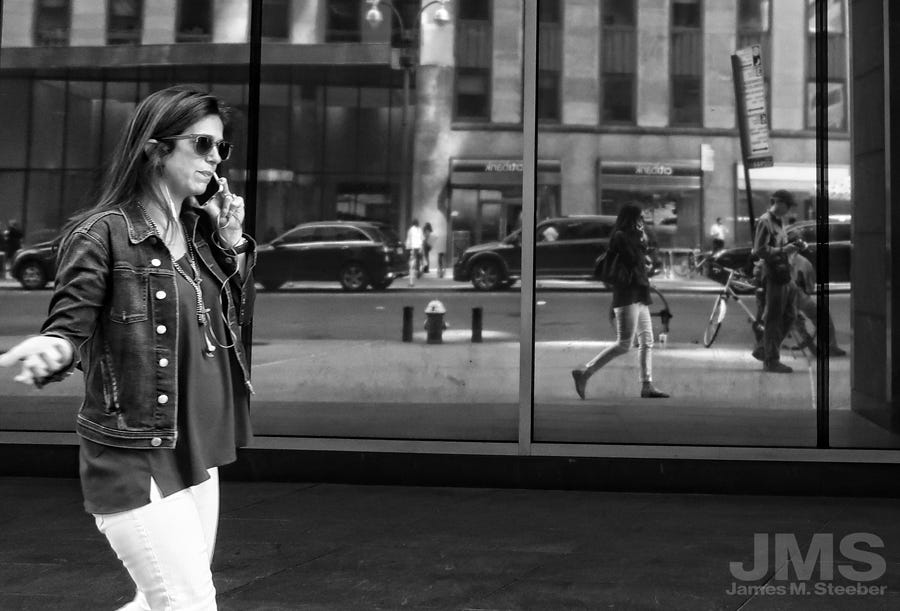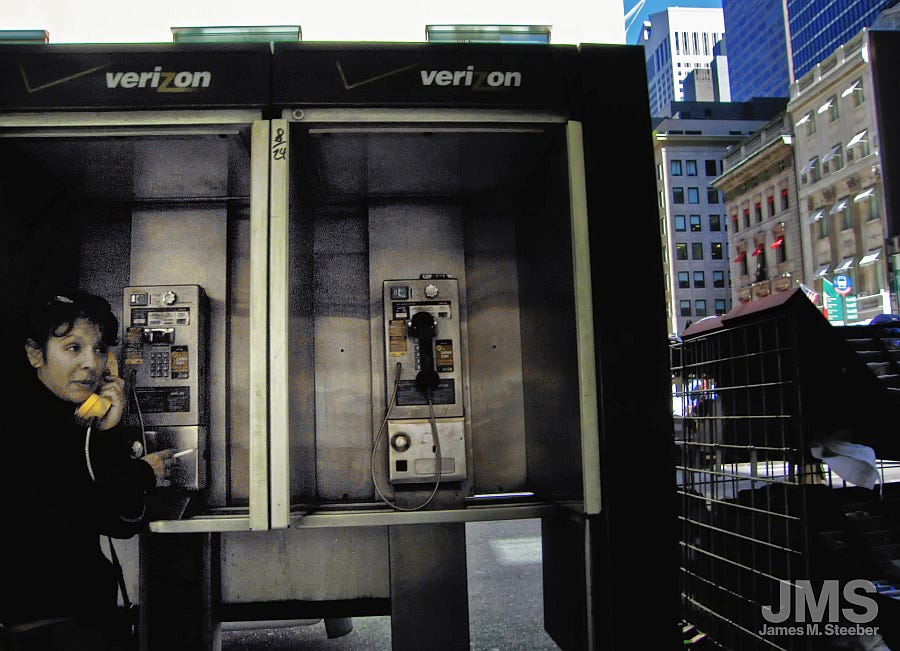Mobile phones have ruined the art of walking in New York. There are little islands that approach you in the form of a person with hand-at-ear (or simply talking into air). Momentarily you know it will be impossible to keep an uninterrupted thought in your head. Walkers and talkers are like little intruding radio stations on adjacent frequencies. They become impossible to ignore, bowdlerizing in their wireless bliss of disconnection from everything else. The wave harkens back to the 1911 Irving Berlin tune Everybody’s Doin’ It, but instead of dancing a ragtime two-step, the rage is simply being on a call.
On the street I'm often aurally sealed off of the sound landscape with ambient sounds coming through my earbuds, which can make a visit to the grocery store seem like a silent film sequence with breathing sounds as in 2001 A Space Odyssey. On an average visit to the store, there may be three or four people chatting away while staring ahead – often with what look like extinguished cigarettes in their ears. Given that most people fitted out with anything that blocks their ears will compensate for it, they speak louder than they have to. Therefore, what may have been a thought in my head now becomes a captive moment of a stranger’s day. And the stranger craves the company coming over the phone, even for comparing melons.
The commercialism of phone use decrees that more and more attention must be paid to the device one buys on time until the next issued device renders the previous one a useless relic, so what was once a novelty of utter fascination – being able to call from anywhere – is now considered a sacrosanct component of life – so much so that it is quickly becoming the most distinctive addiction – dwarfing even smoking during its peak.
To keep the narcotic-like highs in play, users are offered newer novelties, like the ability to see the person to whom they’re connected. This comes paradoxically with an increasing need to distance oneself from the device in part from fear of microwave contamination (i.e., tumors). The result is that more and more people are talking to their phones at arm’s length – shouting to the gadget that now shouts back through its surprisingly robust and yet tiny speaker. Our 1930’s Dick Tracy fantasy has come to fruition, and it is no glamorous reverie.
I have observed that the quality and circumstance of these wireless meetings, with or without a picture, seems at times to cause more stress than comfort. Years ago, I started to notice that there were a lot of one-sided arguments happening on street corners, prompted by mobile phone users who found each successive phrase and sentence to be increasingly provocative.
Sentences were being cut off, I figured, by the little delay inherent in digital phone connections – what is known as latency - caused by storing or buffering a moment of the call before moving on so that the sound will stream out without interruption. The problem is that this necessary and tiny delay results in unnatural timing between two people who would ordinarily, as on a traditional telephone, be able to talk back and forth, even interrupting one another as in a natural conversation. In the digital-delay time-shifted era this can be terrible for those who can’t abide by need to listen first, then talk. Passersby will hear the most personal and impassioned argument that once would have been the domain of the home. “You did not hear me say that to you!”, I would sometimes hear. Could it be that the device itself is causing this form of suffering?
I digress!
Telephone company payphones were once ubiquitous throughout the world. In 80’s New York City they’d sometimes be offered in packs of four or more on a street corner. Beneath Rockefeller Center you would find as many as twelve of them in a row. At Grand Central Terminal there were complete booths – blocks of five or six – often unavailable because of constant demand. What the booths all had in common is that they offered a little discretion – even quiet – so that a conversation could commence.
Now shorn of this traditional protection phone users have no suggested rules to follow, so that what used to be a point of privacy has now become its inverse – loud personal utterances that are simply to be ignored by everyone else, if they can. At the same time there is a form of pride developing out of mobile phone culture – the sense that having a call is a sign of relevance and importance. It’s the basic fantasy of wanting to be or appearing to be always busy.
Without rules the boundaries disappear – people answering phones while watching live plays in a theater, people chatting obliviously away, inches from others on a bus, and the blind phone walkers – those who find ways to look at the screen continuously no matter what they are doing, only occasionally “coming up for air”, (as a friend of mine recently observed) now navigate while spotting the walk ahead like a ballerina in a pirouette. In museums it is often the phone, not the visitor, that sees the artwork, and at the same time the phone can even conduct the tour. Phone cases are outfitted with saddle-like handles, so that the phone can be handled for hours.
Regarding this dependency on the gadget-nouveau, it isn’t just a matter of being bothered by the sight and sounds of others but what others are doing to themselves.
There is a void which must be filled now – that sense of mental awareness that needs pacification and diversion. No one wants total quiet these days, as it’s too scary, given that we are often sated with “breaking news” as we turn on the television - bulletins that can also be fed to us en route. In less technological times, such interruptions were rare. Aside from an assassination or a tornado warning, TV waited unit the newscast. Radio news was on the hour, and aside from letters in the mail and the morning paper (years after extra editions were the rage), there was no other way to get news in any detail.
To fill that psychic void, people went out to eat, met at bars, took themselves out to the movies and chatted on park benches. The lonely would wander out, window shop, answer personal ads, and gossip at the office, but all that in between time was quiet time or music listening. When not at home or in a car one heard ambient sounds of the city or country. The SONY Walkman and its imitators intruded on this concept as the 80’s commenced, but there were limitations of battery life, cassette tape length, and radio reception, not to mention the fact that it all had to be carried around. A person with inner thoughts could still survive and thrive on a blissful walk astride Central Park, until recently.
The latest thrill – living one’s life on the phone began with the first true multitasking phone – the iPhone of 2007 (followed by the Droid of 2008). In June of 2022 we’ll be able to celebrate 15 of the modern smartphone (a term coined ten years earlier by Ericsson for a less practical device), where phone, camera, social media, Web, texting, email, and myriad “apps” (including games) were eventually combined into a minute package easily stored in a pocket. Through relentless competition and refinement, the smartphone became not simply a thing to show off but an extension of the human being – even a requirement. The corporate world made this affordable and “unlimited” and eventually succeeded in pulling customers off of their home telephones and onto the smartphone where a commercial universe could be fed in regular doses – even around the clock.
The blissful walk by the park is now dotted with voice pollution carriers – those without rules or boundaries who exist in a bubble of virtual contentment where the remainder of reality is duly ignored – a painful detriment to those who simply want to stoke that inner life - that source of imagination that ruminates, questions, and observes. The idea that people once spotted talking to themselves were strictly from the fringes of society has been revised. Everybody’s Doin’ it Now.
End of Part 1





